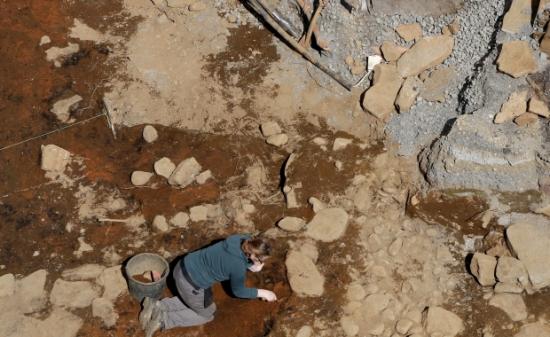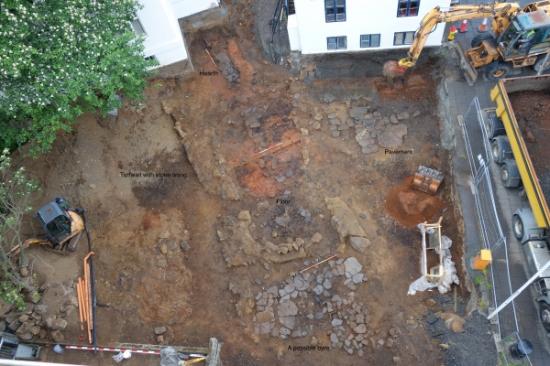Magnus Sveinn Helgason
Source – http://icelandmag.visir.is/article/news-report-viking-age-settlement-emerging-downtown-reykjavik
 The recent discoveries bring into stark relief how little we actually know about Viking Age Reykjavík. Photo/Andri Marínó Karlsson
The recent discoveries bring into stark relief how little we actually know about Viking Age Reykjavík. Photo/Andri Marínó Karlsson
Visitors to Reykjavík this summer have had the rare opportunity of watching from the sidewalk as archaeologists uncover one of the largest known Viking longhouses found in Iceland. The longhouse, which emerged in an archaeological dig in a downtown parking lot, where a new luxury hotel is scheduled to be constructed, have forced historians to re-write the history of Viking Age Reykjavík.
Home to a chieftain
The excavation has so far uncovered the ruins of a longhouse which was at least 20 meters (66 feet) long. The total dimensions of the building will probably never be established as the nearby houses were built on top of it. “Both of its ends were cut off by construction when the nearby buildings were built”, archaeologist Lisabet Guðmundsdóttir, who is in charge of the dig by Lækjargata street, tells us. The site was therefore partially destroyed by development, making it impossible to tell exactly how large the longhouse was.
 THE LÆKJARGATA LONGHOUSE Photo/Reykjavik City Museum
THE LÆKJARGATA LONGHOUSE Photo/Reykjavik City Museum
However, what was preserved under the parking lot and backyards of nearby houses has allowed the archaeologists to establish that it is one of the largest Viking-era longhouses found in Iceland. The long-fire, or hearth, which stretched along the middle corridor of all Viking longhouses, is certainly the longest found in Iceland, measuring 5.2 meters (17 feet). The size of the building shows it was the home of someone of considerable wealth and status.
A decision has not been reached on whether and how the find will be preserved. A new four-star hotel has been planned for the site.
Construction work for the hotel will start after the archaeologists have explored the area completely and the excavation is completed. “All the stones are numbered, and all the information preserved, so the structure or a part of it could be reconstructed,” Lisabet points out. The developer has indicated he might wish to have the long fire reconstructed as a permanent exhibition in the hotel.
Viking Age Reykjavík was a vibrant village
 Map by Ivan Burkni/Iceland Magazine
Map by Ivan Burkni/Iceland Magazine
Anna Lísa Guðmundsdóttir, archaeologist at the Reykjavík City Museum argues that the discovery of the longhouse is very important, as it shows that the Viking Age settlement in Reykjavík was significantly larger than previously believed:
“It has expanded the area where we can expect to find settlement era remains. Previously we had primarily focused on the area on the southern end of Aðalstræti street [8-10 on the map], and the northern ends of Suðurgata and Tjarnargata streets [3-7 on the map]. The distance between that site and the current find is 200 meters (660 feet), demonstrating that we can expect settlement age finds over a significantly wider area than we had previously expected.“
Vala Garðarsdóttir, an archaeologist who oversaw the excavation by Tjarnargata street (number 6 on the map) , south of the House of Parliament in 2008-9 agrees. When this most recent discovery is added to the archaeological discoveries in downtown Reykjavík over the past few years, we are seeing a picture of a vibrant small village:
“The site along Tjarnargata street revealed several smithies and workshops, most importantly ironworks but also silverworks, a woodshed and as well as workshops for toolmaking, processing skins, wool and foodstuffs and a brewery. This was clearly the industrial area of a small village. Everything we have found shows we are looking at a vibrant village at the time of settlement.”
Vala adds that a wooden walkway, which stretched along a boundary wall which separated the lake from the industrial area to its west, was perhaps the most amazing find, since it was the first street in Reykjavík. The discovery of the longhouse by Lækjargata street (number 13 on the map) shows this village was larger than previously believed.
In the ninth century the downtown lake extended much further to the north. At the time the ironworks were on the western shore of the lake, while the newly found longhouse would have stood on the eastern shore of the lake. It would also have stood on the banks of the short river that connected the lake to the sea. Today the river runs in a sewer beneath Lækjargata street.
Only small patches have been explored
Further excavation is now planned in a parking lot to the south of the current site (number 14 on the map). According to Lisabet Guðmundsdóttir preliminary digs in that area have shown that it contains settlement age structures and remains. “However we do not know what condition they are in. The area has been disturbed far more through the years than the site we are currently excavating.”
In fact, there are very few areas in downtown Reykjavík that remain undisturbed. But Lisabet believes there are some very promising sites worth exploring:
“Most importantly there is Austurvöllur Square, in front of the House of Parliament [number 12 on the map], and the old cemetery, Fógetagarðurinn, by Aðalstræti street [number 11 on the map]. There are also a few parcels here and there, including a parking lot on the corner of Vonarstræti and Suðurgata [number 3 on the map], which have only been partially explored. And there might also be undisturbed archaeological remains under some of the streets and sidewalks.”
In the past, people did not pay attention to possible archaeological remains when they dug for the foundations of buildings or roads. Lisabet points out that both ends of the longhouse by Lækjargata were cut off when the nearby buildings were constructed. “People didn‘t know any better, and it was perhaps also impossible for them to know what they were doing.” A piece of a Viking Age wall does not look much different from other rocks in the ground to the untrained eye. “It is impossible to know what has been destroyed over the past century as Reykjavík has grown into a city.”
The recent discoveries bring into stark relief how little we actually know about Viking Age Reykjavík. Lisabet argues that very important work remains to be done, both in the ground, literally, and above ground. “The important task for the coming years will be to fill in the gaps, but perhaps more importantly, to study these finds in context, their distribution and connections.”
In the meantime we can watch the archaeologists at work from the sidewalk on Lækjargata street, and fill in the gaps with our imagination.